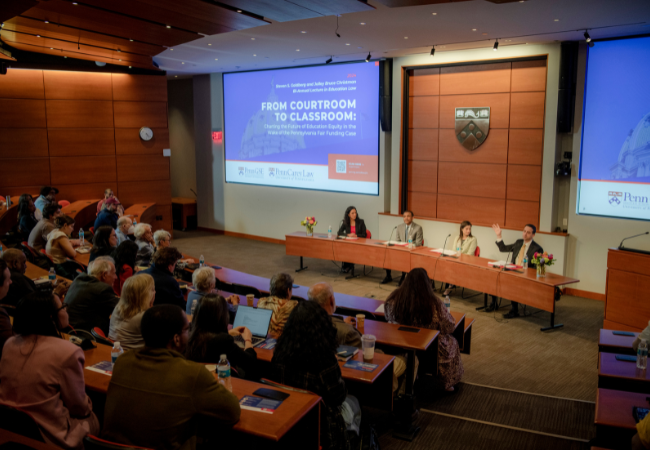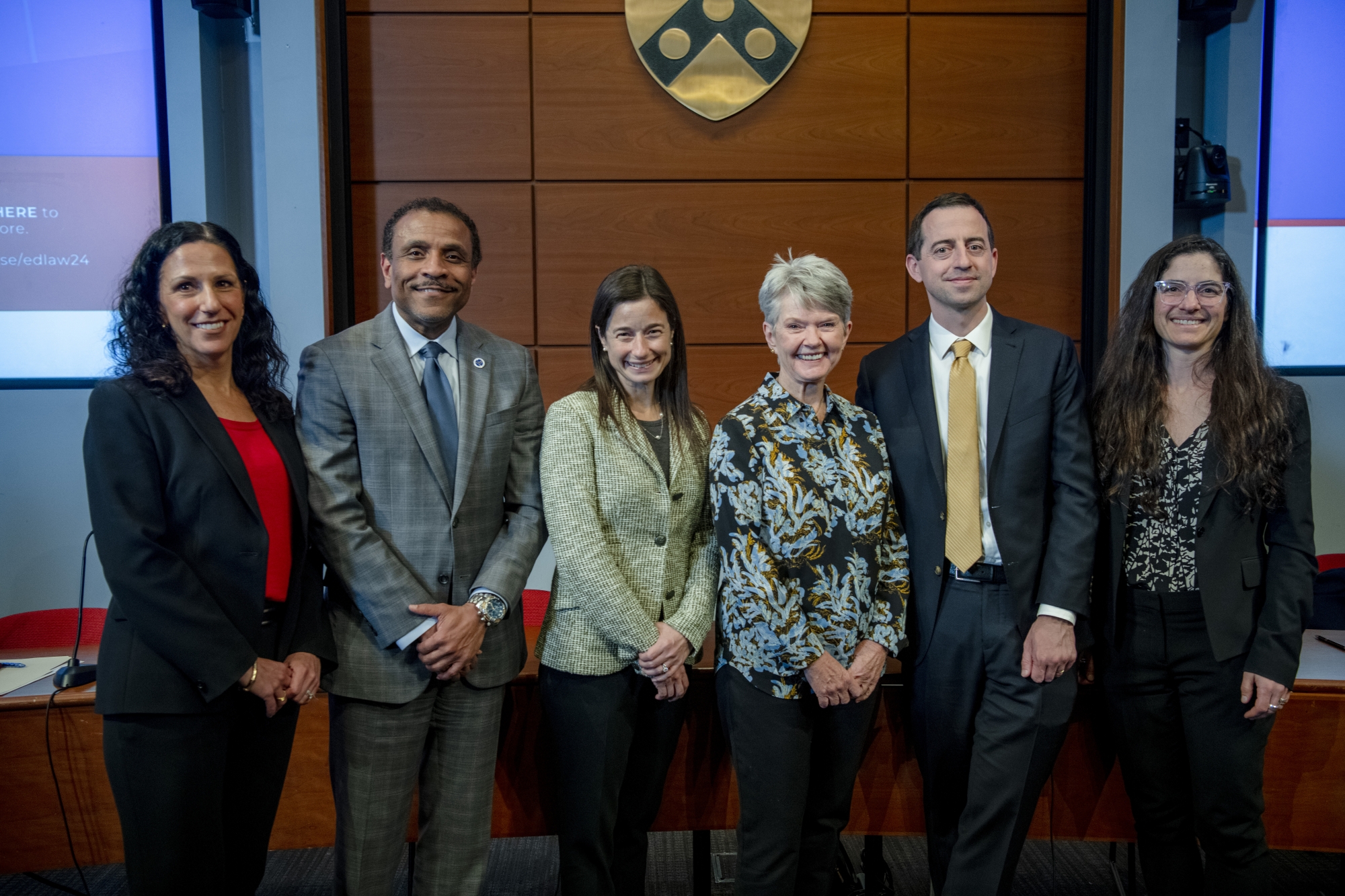Education law lecture explores landmark case demanding equitable school funding for Pennsylvania

More than 100 guests from the Penn and Philadelphia communities attended the 2024 Goldberg–Christman Education Law lecture, which is a collaborative initiative between Penn GSE and Penn Carey Law. (Holden Blanco for Penn GSE)
It has been over a year since the Pennsylvania Commonwealth Court found the state’s formula for funding its schools to be unconstitutional. What has happened since that landmark case was won and the legal arguments that helped win it were on the docket at the recent Steven S. Goldberg & Jolley Bruce Christman Bi-Annual Lecture in Education Law.
This year the lecture, which presents a public discussion focused on timely and consequential topics at the intersection of education, policy, and law, was titled “From Courtroom to Classroom: Charting the Future of Education Equity in the Wake of the Pennsylvania Fair Funding Case.” It featured two advocates from the case — Deborah Gordon Klehr, executive director of the Education Law Center, and Dan Urevick-Ackelsberg, L’09, senior attorney at the Public Interest Law Center — as well as School District of Philadelphia Superintendent Tony B. Watlington, Sr.
Introduced by Penn Carey Law Dean Sophia Z. Lee and moderated by Penn GSE Dean Katharine O. Strunk, the panel covered the conditions in Pennsylvania that led to the lawsuit, what “equitable funding” could or should look like for the 500 diverse school districts across the state, and the specific needs and impacts in Philadelphia.

Gordon Klehr began by highlighting the inadequacy of the current funding model, which relies heavily on local property taxes and, therefore, disadvantages low-wealth districts. While districts across the country are funded by some combination of federal, state, and local dollars, Pennsylvania is among the most reliant on local money.
“When we filed the case, Pennsylvania was paying about 36 percent of the funds to school districts — about 10 percentage points lower than most other states,” she said. “And that had a huge impact on our schools and inequity because districts then had to rely on local wealth to raise the money they weren't getting from the state.”
That matters, said fellow lawyer Urevick-Ackelsberg, because the Pennsylvania constitution requires a “thorough and efficient system” of education for all students. He discussed the historical principles of the constitution’s language and how it led to the ruling.
“The court said the components of that ‘thorough and efficient system’ include, among other things, sufficient qualified and effective staff, safe and adequate school facilities, adequate up-to-date, modern curriculum, and modern instrumentalities of learning, things like technology and books,” he said.
Superintendent Watlington, who came to Philadelphia from leadership positions in North Carolina, noted the “stark difference” between the way the two relatively similar states fund their public education systems. Teacher and principal salaries, he said, are entirely state funded in North Carolina, where he served in two districts.
“Neither district was Rockefeller rich, they both were low-wealth districts with the population very diverse, similar to Philadelphia, and 100 percent — 100 percent! — of the schools had adequate heating and air conditioning systems year-round,” he said. “It was shocking to note, here in Philadelphia, that 57 percent of our schools don't have adequate air conditioning, such that when the mercury goes up, we have to send kids home early. And certainly, if there's any place where kids need more time in school, it’s in what's referred to as the nation’s largest poor city. That’s a big challenge.”
The lawyers were quick to note that the infrastructure challenges, including lack of adequate temperature control, were not even part of the $5.4 billion that they say represents the current funding shortfall. That number, said Urevick-Ackelsberg, was determined by identifying the districts across the state that are meeting proficiency metrics and standards, discovering what they spend relative to the needs (including special education and English language learning needs) in their district, and then using that as a model to determine the needs for the other districts.
Urevick-Ackelsberg said that while that could mean about $1.4 billion in additional annual funding for Philadelphia — which Watlington said would be used to grow and retain highly qualified teachers, principals, and counselors, and for investments in curriculum — these are shortfalls that affect most districts all across the state, large and small. And the plaintiffs in the school funding lawsuit, which did not include the School District of Philadelphia, were chosen specifically to represent that.
“The truth is that rural, urban, suburban schools in all parts of the state were — are — underfunded, and don't have what they need,” said Gordon Klehr. “We ultimately picked six school districts that had high tax effort, but low tax capacity, efficient with what they had and still unable to provide for their students’ needs because of lack of state support. We had geographically diverse school districts, and, in addition, also the Pennsylvania Association of Rural and Small Schools and the NAACP Pennsylvania State Conference, because, again, beyond those six named school districts, so many students in so many public school districts across Pennsylvania suffered as a result of the unconstitutional funding system.
“And then, we had parents and students, families from Wilkes Barre and William Penn [School District] and Philadelphia,” she continued, “so that they could share their lived experience with the court about what it was like to go to schools so underfunded.”
Note: This video was captured by the stationary, in-classroom camera during the event.
In the year since the lawsuit’s conclusion, the state convened a bipartisan Basic Education Funding Commission, which held hearings across Pennsylvania and made its recommendations early in 2024. Those recommendations offer one possible model for creating a constitutionally compliant funding system that acknowledges the $5.4 billion adequacy gap and takes seven years to fill that gap. The governor’s recent budget proposal, should it be approved later this spring, includes the first of those seven years of increased education spending.
While that means Pennsylvania’s students are still awaiting adequate funding of their educations, it is a step in the right direction, the panelists agreed. The historic fair funding lawsuit made certain that how the commonwealth funds its schools must change; the Pennsylvania constitution demands it.
“Education is a fundamental right in Pennsylvania as a result of this case,” said Gordon Klehr, who read from the judge’s decision: “The education clause requires that every student receive a meaningful opportunity to succeed academically, socially, and civically, which requires that all students have access to a comprehensive, effective, and contemporary system of public education. Respondents have not fulfilled their obligations to all children under the Education Clause in violation of the rights of petitioners.”
The Goldberg Christman Lecture Series was founded in 2016 by Penn GSE Board of Advisors member Dr. Jolly Bruce Christman, GED’71, GR’87, a former Philadelphia school teacher and the co-founder of Research in Action. The series reflects the long-standing commitment to justice and advocacy at the intersection of education and law that she and her late husband, Steven S. Goldberg, GR’85, shared.
